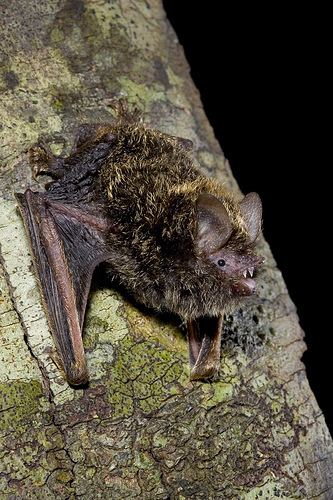Family Vespertilionidae | Phylum Chordata Order Chiroptera Genus Kerivoula Rank Species | |
 | ||
Similar Hoary wattled bat, Scotorepens, Little broad‑nosed bat, Kerivoula, Large‑eared pied bat | ||
First video footage of threatened golden tipped bats in the wild
The golden-tipped bat (Kerivoula papuensis) is a species of Microchiropteran in the family Vespertilionidae. It is commonly found in Papua New Guinea and Australia. Especially, golden-tipped bat is scattered along the eastern part of Australia. The golden-tipped bat is considered as rare and uncommon species. The species is on the list of endangered species in Australia.
Contents
- First video footage of threatened golden tipped bats in the wild
- Description
- Habitat Ecology
- Roosting
- Diet foraging strategies
- References
Description
The Golden-tipped bat (Kerivoula papuensis) is included in a big genus which has range from small to medium-sized bats. The golden-tipped bat has brown color and broken color patterns on its pelage. Body is covered with woolly fur. Broken color pattern gives an advantage of crypsis ability to the golden-tipped bat. Thick pelage and wooly fur helps golden-tipped bat to have increased insulation. The average weight of adult is 6.7g.
Wing of the golden-tipped bat has a low aspect ratio with low wing loading. Low aspect ratio of wing indicates that the wing is broad. The features of wings can make the golden-tipped bat to fly slowly. Additionally, this species has large tail membrane so broad wing and tail membrane help golden-tipped bat to turn tightly when they are flying. Round wing tips is another feature of wing and it is related with high maneuverability.
The golden-tipped bat also use echolocation for foraging. The sweep of the echolocation by the golden-tipped bats is about 155 kHz to 60 kHz.
Habitat & Ecology
Majority of data about the golden tipped bats have been recorded in Australia and Papua New Guinea. Recently, from the distributed areas of western coast of Australia, scientist could capture more species than the past(1980's~90's) by using developed techniques such as sonar detection system. Predominantly, golden-tipped bat has been recorded in a variety of rainforest sites or wet sclerophyll forest. Also a small number of individual records in dry sclerophyll forest. They live at elevation up to 1,000m.
Roosting
A roost is important resource for the golden-tipped bat. The golden-tipped bat makes diurnal roosts ranging from 0.5 to 9.0m above the ground. They are roosting on the branches of the tree or tree hollows. Females bat uses canopy tree for a maternity site. This site helps female to lactate. The large numbers of diurnal roosts are taken by single males or females and some group roosts are bigger than the single roosts. Roosts and the pelage with broken color patterns make the species possible to camouflage from the predators.
Diet & foraging strategies
Diet
Araneida such as orb-weaver and big-jawed spiders is main food of golden-tipped bat. Most particles between the species' teeth and fur are body pieces of Araneida. Araneida can be consumed by golden-tipped bat in both wet and dry seasons. Even though Araneida is a major food of golden-tipped bat, golden-tipped bats also consume insects which belong to coleoptera (beetle) and lepidoptera (insect).
Foraging strategies
The golden-tipped bat uses foraging strategies to hunt preys. One is ground gleaning so the golden-tipped bat catch the preys which are on the ground. The other one is hover-gleaning strategy so they fly slowly and take preys which are on the elevated places such as high tree trunks. The last one is using echolocation. The golden tipped bat use broad bandwidth echolocation to find precise localization of a target. Additionally, they use high frequencies echolocation to find the stationary prey such as spider staying in quiet web.
